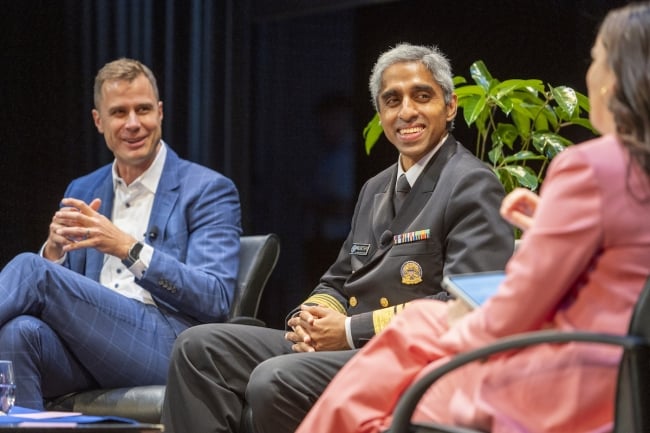You have /5 articles left.
Sign up for a free account or log in.

Surgeon General Vivek Murthy speaks with professor Kate Bowler and men’s basketball coach Jon Scheyer at the Page Auditorium at Duke University.
Duke University
On the first stop in his “We Are Made to Connect” campus tour, U.S. surgeon general Vivek Murthy visited Duke University Oct. 25 to spread his message about the importance of social connection. Speaking at Page Auditorium, he told students how he first became aware of the growing problem of loneliness when he traveled the country during his first term as surgeon general under the Obama administration.
“I heard a lot of stories that you might expect: people who were concerned about the addiction crisis in their community. Folks who were worried about rising rates of depression and anxiety that they were seeing among young people,” he said. “But I also started to hear these stories about loneliness. I heard from young students who were on college campuses who would say, ‘I’m surrounded by hundreds of other kids here, but I don’t know; I feel like nobody really knows me for who I am. I feel like I can’t be myself.’”
The Duke visit launched the surgeon general’s planned monthlong tour of college campuses across the country to talk up his “5-for-5 Connection Challenge,” in which he encourages students to take five actions for five consecutive days that express gratitude, offer support or ask someone for help.
“Just like exercise and nutrition, our relationships with one another are fundamental components of our overall health and well-being,” he said in a statement announcing the initiative. “The tour and connection challenge will help students learn how to better incorporate moments of connection into their daily lives.”
At Duke, some students met with Murthy ahead of his public appearance. Carson Lender, a sophomore psychology major, said she and other students told the surgeon general about their “own experiences as students here, what Duke has been doing to combat this sort of loneliness epidemic that we face—specifically post-pandemic, because it’s really hard to get back connected and to get back into the swing of things after this.”
A Widespread Issue
Loneliness is not a problem exclusive to college students; Murthy has declared it a national epidemic, and one with potentially devastating health consequences. Studies have linked loneliness to an increased risk of heart disease, stroke, dementia and premature death. Research has also shown a correlation between loneliness and suicidality. Murthy released a report in May outlining the various dangers of loneliness and suggesting ways the nation can address the epidemic, beginning with increasing public awareness and designing social infrastructure to help build connections.
But studies show that loneliness is more prevalent among young people. While 17 percent of people over 65 worldwide say they feel lonely, 27 percent of the 19–29 cohort do, according to a poll by Meta and Gallup released in late October.
In a Gallup poll specifically of college students, which was released in August, 39 percent said they had experienced loneliness the previous day. While it wasn’t the top concern for students—that appeared to be stress, which 66 percent of students reported experiencing the previous day—loneliness ranked above sadness (36 percent) and anger (25 percent).
The student loneliness epidemic is often associated with the COVID-19 pandemic shutdowns, which prevented young people from making connections in their usual classroom and extracurricular settings, but the issue dates to well before 2020.
“Unfortunately, this has been a long-standing public health crisis that many are just learning about. Millions of Americans experienced loneliness before the pandemic, but conditions have worsened in recent decades,” Shannon Vyvijal, spokesperson for the Foundation for Social Connection, a nonprofit aimed at combating loneliness and isolation among Americans, wrote in an email to Inside Higher Ed. “For example, more people live alone now. We are less involved in community groups. We are spending less time with our family and friends.”
Certain aspects of modern life have exacerbated the trend for college students. Marcus Hotaling, president of the Association for University and College Counseling Center Directors, believes technology has made it easier for college freshmen to stay in touch with their high school friends, which may benefit those relationships but can also diminish the desire to form new connections on campus.
“It’s so much easier now to maintain relationships with your friends from home and with people at home that you almost don’t recognize, ‘I’m just in these digital relationships. I have one or two close friends, but I do feel somewhat lonely,’” he said.
Can Colleges Help?
Colleges have long offered students opportunities to connect with their peers, from clubs and intramural sports to themed residence halls.
Destiny Patton, a first-year student at the Rochester Institute of Technology, said she struggled to make friends her first few months—in part because demographically, the campus was very different from her hometown of Birmingham, Ala., a majority-Black city.
Now things have changed. She feels comfortable approaching classmates and talking to peers out of the blue—even if they’re not particularly receptive—in order to make friends.
She credits the university with helping her adapt. One of the first friends she met came from a “speed friend-ing” event—like speed dating, but with the goal of finding a platonic rather than a romantic match—hosted by two RIT residence halls.
“The event was packed because people were dealing with the same issue, they just don’t vocalize it,” she said. “Even if [universities] don’t think anyone will show up [to such an event], they should have it, because you never know what could come out of it.”
Other institutions are experimenting with new ways to help students forge connections.
Last year Duke introduced an initiative called QuadEx, in which all the students in a given freshman dorm move to a corresponding sophomore dorm their second year, meaning they live with the same community for their first two years—and onward, if they so choose. The program aims to give students a residential community and home base where they always feel welcome.
“It’s a belonging intervention for undergraduates designed to help them be connected to one another and to the resources of campus from the moment they start their journey on campus,” said Mary Pat McMahon, vice president of student affairs at Duke.
Lender, the Duke sophomore, has really appreciated the university’s efforts to bring students together. Like many students, she felt uneasy and unsure about how to make connections when she returned to in-person learning after COVID-19 shut down her high school. But she said Duke helped smooth the way, in part by hosting events such as movie night and candy apple–making over Halloween weekend.
“Duke does a very great job, when you come in freshman year, to sort of foster relationships and get you to meet a lot of people and make students feel less alone,” she said. “Colleges should continue to do programming and events that they’re hosting that people can go to, so it’s not like the students have to be the ones necessarily reaching out to make the plans and stuff, something that a student may not feel comfortable doing.”
Mary Ann Covey, former director of counseling and psychological services at Texas A&M University, where she worked for 34 years, said some of the best ideas she saw for building connections came from the students themselves.
“[Texas A&M had] this huge influx of people wanting to create their own student organizations. You had like four cupcake-making student organizations,” she said.
Universities should make it a point to broaden the range of activities or events that can help students connect, she said; student affairs professionals can play a valuable role by providing the same support for small niche clubs as they do for larger, more established student organizations.
And for students who can’t be cajoled into joining dormitory trivia night or club karaoke, the first step is figuring out who they are, said Covey. The next step is reaching out.
“You look at completed suicides, and I would probably make the argument that [in most cases] … they were very isolated,” she said. “And people will often kind of kick themselves, like, ‘I should’ve invited that person.’ I don’t want to create that could’ve-would’ve-should’ve environment so much as saying, if you see someone who appears disconnected, how can you reach out?”
Isolation or Loneliness?
Loneliness researcher Laurie Theeke, associate dean for George Washington University’s Ph.D. in nursing program, said universities should be careful not to confuse social isolation with loneliness. Modern research differentiates between social isolation, which, she said, refers to a lack of day-to-day interaction with other people, whereas loneliness refers to the psychological state of feeling like one’s need for love and belonging is not being met.
Most colleges aim to solve the problem of social isolation without addressing the underlying loneliness—which is an extremely personalized struggle that can usually only be addressed by the person in question, Theeke said.
But colleges can support that work by helping students connect with others who are experiencing similar emotions and minimizing the negative connotations of loneliness.
“There’s a stigma associated with loneliness, and it’s this stigma of social undesirability,” she said. “Instead of taking on the challenge of loneliness, they actually self-isolate.”
By reducing the stigma and “making sure students on the campus know belonging is a goal for the university,” she said, colleges may be able to play a more significant role in ending the loneliness epidemic.




